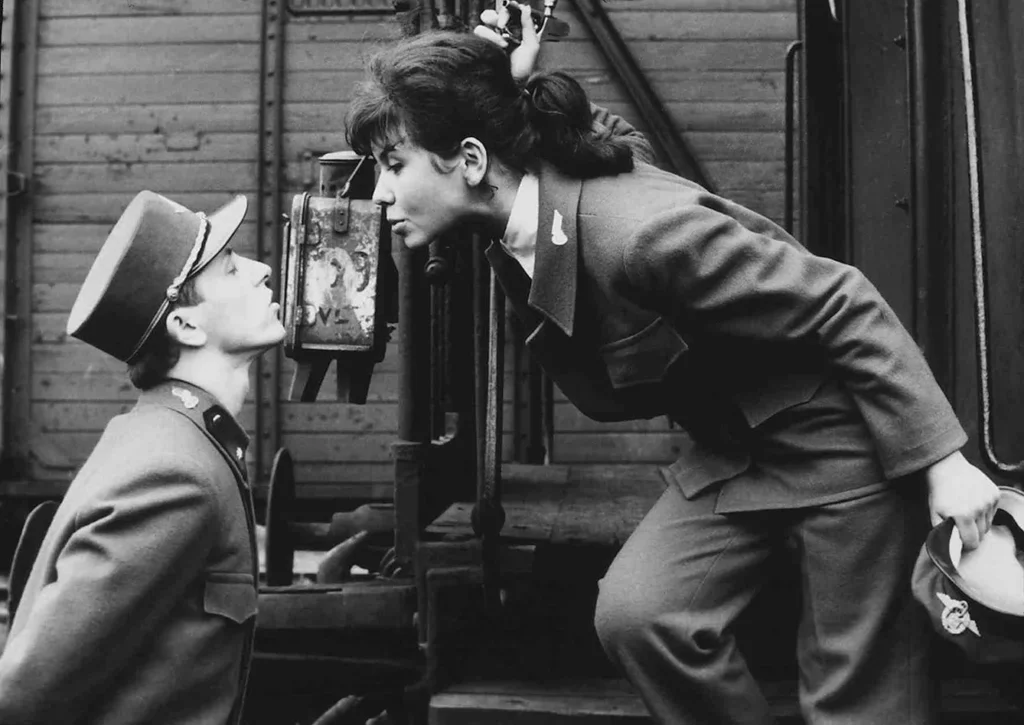Trains in Central Europe have always been more than just a means of transport. They have become a symbol of the journey through life, even an allegory of transience. This is perfectly evident in the culture. In the Czechoslovakian film “Closely Watched Trains” by Jiří Menzel (based on the well-known book by Bohumil Hrabal), the small station becomes a metaphor for the reaction of Czechs to the German occupation during the Second World War – so successful that it was awarded an Oscar in 1968.

Changing the reputation
In the Polish film “Night Train” from 1959 by Jerzy Kawalerowicz, the melodious clatter of wheels against rails turns out to be a symbol of longing feelings and the pursuit of life – so apt that the film was honored at the Venice Film Festival. “Blind Chance” by Krzysztof Kieslowski, made in 1981, presents a train as a turning point in human life. In the Hungarian “Love Film” from 1970 by the renowned director Istvan Szabo, trains became the common denominator, a fixed benchmark for main characters throughout their lives.
For decades, trains in CEE countries were associated with nostalgia – but also technical problems, delays, and underinvestment. During the communist era, the railway network was developed very poorly, and this changed only marginally after the political transformation following the “Velvet Revolution.” While the Western world was constantly developing track-related technologies, time almost came to a standstill in Central Europe in the area of railways. But there is an opportunity for change in this field as countries of the region start developing high-speed rail (HSR). By 2030, the number of high-speed rail traffic is to be doubled.
Overcoming the oil crisis
“Bullet Train” is the title of the cinema blockbuster from 2022 with a celebrity cast including Brad Pitt, Sandra Bullock, Channing Tatum, and Hiroyuki Sanada. But the original “Bullet Train” started operating between Tokyo and Osaka in April 1959. Shinkansen (Japanese prefer this name rather than “Bullet Train”) was the first high-speed train in the world. Western European countries started developing this technology in the 1970s as a reaction to the oil crisis of that time. The best-known examples of HSR are the French TGV trains (“Train à Grande Vitesse”) which started operating in 1981 and are capable of speeds in excess of 300 km/h. Generally, today, Western European countries have a strongly developed network of such connections, spanning over 11,990 km.
Central Europe has been lagging behind for decades. The fastest trains in the region are able to run as fast as 160 km/h – and there are only a few lines adapted to this speed. Investment in modern rolling stock has failed to raise these speeds significantly. The main problem remained the old infrastructure not allowing record journey times to be achieved. Residents of CEE countries could only watch “Bullet Train” in the cinema – but not at stations in their own cities.
But there are increasing signs that a breakthrough in this area could occur this decade. Two reasons. First – projects under the EU program called The Trans-European Network for Transport (TEN-T). Second – organic development of individual countries in the region and their infrastructure. The mega airport planned for the vicinity of Warsaw, which has ambitions to become an interchange hub for the whole of Central and Eastern Europe, plays a special role here. If these plans can be completed, by 2030 the countries of Central Europe will be connected by a high-class railway infrastructure, in addition to being plugged into the network of connections in Western Europe.
Regional village
What is the Trans-European Network for Transport (TEN-T)? “A key instrument for developing coherent, efficient, multimodal, and high-quality transport infrastructure across the EU. It comprises railways, inland waterways, short sea shipping routes and roads linking urban nodes, maritime and inland ports, airports and terminals,” explains the European Commission, which created this mechanism. There are three different railway projects included in this policy, which at least partially cross Central Europe: the North Sea-Baltic Corridor, the Baltic Adriatic Corridor, and the Rhine-Danube Corridor. The first one starts in Belgium and then crosses through the Netherlands, northern Germany, and Poland to the Baltic States. The second goes from ports in the north of Poland to the Adriatic ports of Italy. The third connects Strasbourg in France with southern Germany, Vienna, Bratislava, Budapest, and Bucharest, finishing in the Romanian Black Sea port of Constanta.
The TEN-T policy is not new. It was created in 2013, but since then, it has had several changes. The latest was added at the end of 2022 when the European Commission decided to adjust all projects given the needs highlighted by the pandemic and the war, especially concerning the issue of durability and resilience of supply chains. According to the TEN-T projects, a 4500 km long high-speed network will be created in the Central European countries. It will have a great impact on the whole region as long distances will “shrink” considerably. For instance, right now, travel by train from Budapest to Warsaw takes 690 minutes – but when HSR becomes operational, the time will decrease to 330 minutes. Train travel from Tallinn to Vilnius will take 280 minutes (right now it is 500 minutes), and from Budapest to Prague, it will shrink from 420 minutes to 210 minutes. When the construction of HRS is over, Central Europe will become a “regional village” – at least in terms of railway communication.
Of course, it is not an easy task – and definitely not cheap. Different studies show that the cost of this network will reach 60.3 billion euros. The bulk of investments will be allotted in the period between 2025 and 2029. However, profits should easily exceed outlays. The calculations show benefits will reach the level of EUR 119.4 billion. Only hours in trains saved by passengers thanks to shorter travel times will be worth EUR 54.5 billion. It looks like we will be witnessing a new form of time travel in Central Europe.
Generating change
HSR trains in Central Europe will become a game changer for the whole region as most of the infrastructure will be built to allow speeds in excess of 250 km/h – today, the maximum speed is 160 km/h. But this new high-speed railway will also change the character of the civilization of the entire region. Integrated train timetables in CEE states will allow to minimize the need for cross-border air or car travel. Inhabitants of Central Europe are living closer to each other. This type of change always proves beneficial – from a business perspective as well as a human one. Already today, Poles often go on holiday to the Adriatic, as do Czechs to the Baltic. The expansion of the high-speed train network will mean that all three seas of the region will, in fact, become common waters for the 12 countries in the region.
A further impetus driving the construction of HSR railways will be the plans to build a mega airport 37 km from Warsaw. According to the assumptions, the Central Communication Port (CPK) will start to serve the first air connections in 2028. In the first stage, it will be able to serve 35 million passengers per year, with a target of up to 100 million annually. By comparison, in 2022, Vienna Airport handled 23 million passengers and Munich Airport 31 million. This juxtaposition of numbers alone shows how much of a change in passenger traffic CPK can generate.
But these changes will not happen if the possibility of getting to the new mega airport quickly and efficiently is not created. This is what high-speed rail is designed to do. The railway part of the CPK Programme, which is divided into stages to be completed by 2040, is a web of new lines leading from 10 directions to the CPK located in the very center of Poland. As a result of its creation, commuting by train from the furthest corners of Poland to the central airport (as well as to Warsaw) is expected to take no longer than two hours. The largest cities in the country will be within reach of the network.
All these connections are to be maintained to HSR standards and, according to the plans, will be integrated with lines already under construction as part of pan-European TEN-T projects. Financial support from the EU is important here. Even more important is the integration of the airport into a network of connections, enabling fast travel throughout Central Europe. If this project can be implemented along these lines, it will be the most important infrastructural change in the region since the “Velvet Revolution.”
If successful, it will be a breakthrough in technology and infrastructure – not to mention symbolically. Today, looking at the map of Europe, the Iron Curtain is still clearly visible – if only in the development of the railway network. The differences in the development of railway infrastructure between East and West are still enormous, another consequence of the division of the continent into two blocs at the Yalta conference.
The symbolic dimension of this investment will be particularly evident in the construction of the North Sea-Baltic Corridor as part of the TEN-T policy. Part of it is Rail Baltica – a greenfield rail infrastructure project that will link the Baltic States with the European rail network. This corridor goes through five EU countries: Estonia, Latvia, Lithuania, Poland, and Finland. The first three of them used to be a part of the Soviet Union, which means they have a different rail gauge. The European standard is 1435 mm wide, but in the former Soviet Union, it was 1520 mm. Estonia, Latvia, and Lithuania – all countries still using the old railway network – use this broader gauge. However, Rail Baltica will be built to European standards.
Three Baltic post-Soviet countries will join Europe in this dimension. Because European integration is not only about common organizations, associations, and declarations, but it is also – or perhaps even primarily – about concrete, joint actions, such as a common rail network.







